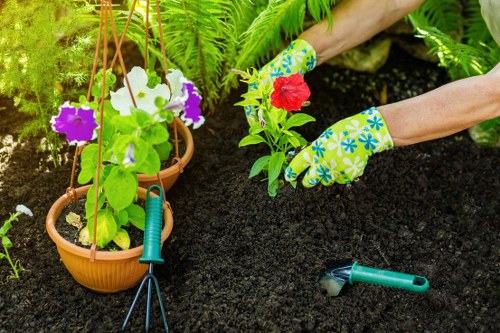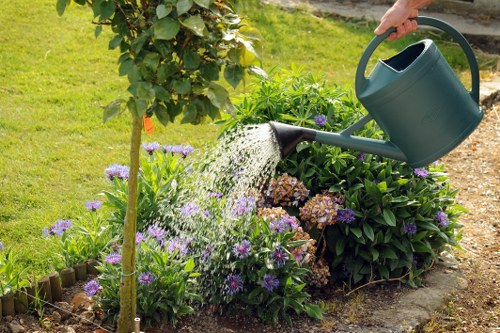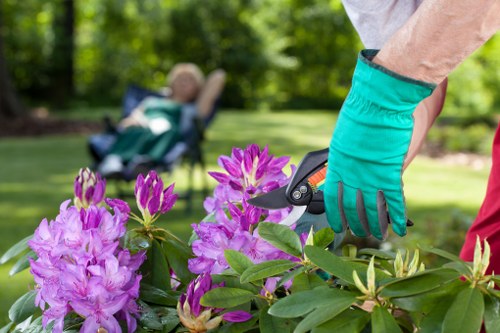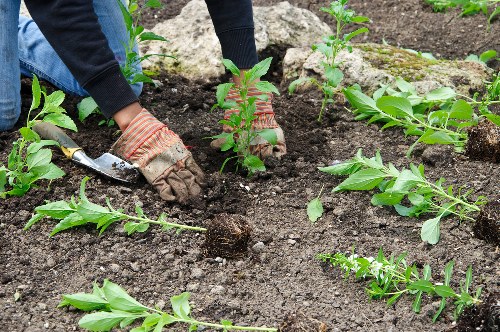Lawn Mowing in Landscape Gardening for Gardeners

Maintaining a beautiful and healthy lawn is a cornerstone of landscape gardening. For gardeners, efficient lawn mowing not only enhances the aesthetic appeal of a garden but also promotes the overall health of the grass and surrounding plants. In this comprehensive guide, we delve into the essential aspects of lawn mowing that every landscape gardener should know.
Proper lawn mowing techniques can significantly influence the growth and vitality of your lawn. By understanding the best practices, tools, and seasonal adjustments, gardeners can achieve a lush, green lawn that serves as the perfect backdrop for any garden design.
Whether you are a seasoned gardener or a novice, mastering the art of lawn mowing is pivotal in landscape gardening. This article explores various strategies and tips to help you maintain a pristine lawn all year round.
Choosing the Right Mower

Selecting the appropriate lawn mower is the first step towards effective lawn care. There are several types of mowers available, each suited to different lawn sizes and terrains. Understanding the features and benefits of each mower type can help you make an informed decision.
Manual Reel Mowers: Ideal for small lawns, these mowers are eco-friendly and provide a clean cut without the use of gas or electricity.
Electric and Battery-Powered Mowers: These offer a balance between power and convenience, suitable for medium-sized lawns with minimal noise and emissions.
Optimal Mowing Techniques

Proper mowing techniques are essential for maintaining a healthy lawn. Adhering to the right height, mowing frequency, and pattern can make a significant difference in the appearance and resilience of your grass.
Grass Cutting Height
Maintaining the correct grass height is crucial. Cutting the grass too short can stress the plants, making them more susceptible to weeds and diseases. Generally, keeping your lawn at a height of 2.5 to 3.5 inches is recommended for most grass types.Mowing Frequency
Regular mowing encourages dense grass growth and helps prevent the establishment of weeds. During peak growing seasons, mowing once a week is typically sufficient, while in slower growth periods, reducing the frequency can be beneficial.Seasonal Lawn Care

Lawn care requirements vary with the seasons. Adapting your mowing practices to the changing weather conditions ensures that your lawn remains healthy and vibrant throughout the year.
Spring Maintenance
Spring is a critical time for lawn care. It is essential to remove winter debris, aerate the soil, and begin regular mowing as the grass starts to grow.Summer Care
During the summer, lawns may require more frequent watering and mowing. It's advisable to mow in the early morning or late evening to avoid the hottest parts of the day.Tools and Equipment

Having the right tools and maintaining them properly is vital for effective lawn mowing. From mower blades to accessories, each component plays a role in achieving a well-manicured lawn.
Blade Maintenance
Dull blades can tear the grass, leading to a ragged appearance and increased vulnerability to pests. Regularly sharpening or replacing mower blades is essential for clean cuts.Additional Accessories
Attachments such as mulching kits, baggers, and edging tools can enhance the functionality of your mower, allowing for a more tailored lawn care approach.Eco-Friendly Mowing Practices
Sustainable lawn mowing practices not only benefit the environment but also contribute to the long-term health of your garden. Implementing eco-friendly techniques can reduce your carbon footprint and promote biodiversity.
- Grasscycling: Leaving the clippings on the lawn recycles nutrients back into the soil.
- Energy-Efficient Mowers: Opting for electric or manual mowers decreases reliance on fossil fuels.
- Water Conservation: Mowing at optimal heights reduces water evaporation and maintains soil moisture.
Contact us today to learn more about sustainable lawn care practices and how we can help you achieve an eco-friendly garden.
Common Lawn Problems and Solutions
Even with regular mowing, lawns can encounter various issues. Identifying and addressing these problems promptly ensures a healthy and attractive lawn.
Weed Infestation
Weeds compete with grass for nutrients and can quickly overtake a lawn. Implementing proper mowing techniques and using weed-resistant grass varieties can help mitigate this issue.Disease Management
Fungal diseases can weaken grass, making it susceptible to pests and environmental stress. Ensuring adequate airflow, proper mowing height, and appropriate watering can prevent most lawn diseases.Enhancing Lawn Health
Maintaining lawn health goes beyond mowing. Integrating fertilization, aeration, and overseeding into your lawn care routine can lead to a thicker and more resilient turf.
Fertilization
Applying the right type of fertilizer at the appropriate times ensures that your lawn receives essential nutrients for growth and color.Aeration
Aerating the soil alleviates compaction, allowing roots to access more oxygen and nutrients. This process is especially beneficial for lawns with heavy foot traffic.Advanced Lawn Mowing Techniques
For gardeners looking to take their lawn care to the next level, advanced mowing techniques can provide superior results. These methods focus on precision and customization to cater to specific lawn conditions.
Strip Mowing
This technique involves mowing in straight, parallel lines, which can help improve lawn density and reduce weed growth. It also creates a visually appealing striped pattern.Clipping Height Variation
Adjusting the mowing height in different areas of the lawn can address varying sunlight, soil conditions, and grass types, ensuring each section thrives optimally.Integrating Lawn Mowing with Overall Landscape Design
Lawn mowing is an integral part of the broader landscape design. Coordinating mowing practices with other gardening activities ensures a harmonious and well-maintained outdoor space.
Harmonizing with Plant Beds
Maintaining clear edges around plant beds and pathways enhances the overall look of the garden and prevents grass from encroaching into desired areas.Seasonal Planting
Aligning mowing schedules with seasonal planting ensures that new plants are not disturbed and have adequate time to establish themselves.Safety Tips for Lawn Mowing
Safety should always be a priority when operating lawn mowers. Following proper safety protocols minimizes the risk of accidents and injuries.
Personal Protective Equipment (PPE)
Wearing appropriate PPE, such as gloves, safety glasses, and sturdy footwear, protects you from potential hazards while mowing.Mower Maintenance
Regularly inspecting and maintaining your mower ensures that all components function correctly and reduces the likelihood of malfunctions during use.Cost-Effective Lawn Mowing
Maintaining a lawn can be costly, but with smart strategies, gardeners can manage expenses without compromising on quality. Investing in efficient tools and adopting sustainable practices can lead to long-term savings.
- Invest in Quality Equipment: High-quality mowers may have a higher upfront cost but tend to last longer and perform better, reducing the need for frequent replacements.
- DIY Maintenance: Learning basic mower maintenance can save money on professional servicing.
- Efficient Scheduling: Optimizing mowing schedules based on lawn growth can reduce energy consumption and wear on equipment.
Enhance your lawn care routine today by implementing cost-effective strategies that ensure a beautiful and healthy garden without breaking the bank.
Conclusion
Lawn mowing is a fundamental aspect of landscape gardening that requires knowledge, skill, and dedication. By choosing the right mower, employing optimal mowing techniques, and integrating sustainable practices, gardeners can cultivate a vibrant and resilient lawn.
Regular maintenance, coupled with advanced strategies, ensures that your lawn remains a stunning feature of your garden throughout the year. Embrace these practices to elevate your landscape gardening experience and enjoy the myriad benefits of a well-manicured lawn.



